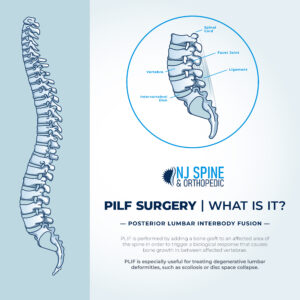Posterior Lumbar Interbody Fusion
Find out which treatment or treatments are right for you by trying our 2-min Guided Pain Assessment Form!





As with all spinal fusion surgeries, a posterior lumbar interbody fusion (PLIF) is performed by adding a bone graft to an affected area of the spine in order to trigger a biological response that causes bone growth in between affected vertebrae. However, unlike some other spinal fusion surgeries, PLIF achieves spinal fusion in the low back by inserting the graft material directly into the disc space. In a PLIF procedure, the surgeon will approach the spine through an incision made in the back.
This surgery can be carried out for a variety of conditions and with a range of techniques. PLIF is especially useful for treating degenerative lumbar deformities, such as scoliosis or disc space collapse. The best way to determine if PLIF surgery is right for you is to consult a skilled spine specialist.


Discover which treatment options are right for you with our Treatment Finder.
During a PLIF surgery, the spine is approached through an incision—of about 3-6 inches—in the midline of the back. First, the doctor strips the lamina on both sides of the left and right lower back muscles. This allows visualization of the nerve roots. Then, the doctor may trip the facet joints—which are directly over the nerve roots—to give the nerves more room. The nerve roots are then retracted to one side and any disc material affecting the discs are removed. Lastly, the doctor will insert the graft material into the disc space to initiate bone growth.

Have our surgeons perform a Free MRI Review.
The best way to understand if you are a good candidate for PLIF is to consult a spine specialist. Some of the conditions you can treat with a PLIF surgery include:
You may be a good candidate for PLIF if you have any of these conditions and have tried non-surgical treatments without success.
PLIF surgery has some advantages and disadvantages compared with other spinal fusion procedures. One advantage of PLIF surgery is that it can achieve anterior fusion of the disc space without needing a second incision, which would be necessary with an anterior approach. Additionally, PLIF surgery tends to have higher potential for solid fusion rates than some other spinal fusion surgeries. Some other notable benefits of PLIF surgeries include:
These are a few advantages of PLIF over other spinal fusion surgeries. However, one downfall of PLIF is that not as much of the disc space can be removed with a posterior entry as when an anterior approach is used.
If you have been using conservative treatments for your back pain but aren’t seeing results, it may be helpful to consult a spine surgeon to see if a posterior lumbar interbody fusion surgery is right for you.
At NJ Spine & Orthopedic, our surgeons are dedicated to treating your pain and helping you get your life back. Our experienced and board-certified neurologists, neurosurgeons, and orthopedic specialists work together to treat spine and back disorders with minimally invasive techniques. Our doctors understand that every person is unique and requires a personalized treatment plan. At NJ Spine & Orthopedic, we treat people, not patients.
To schedule an appointment with one of our skilled spine experts, call (866) 272-9271 or fill out our online contact form.

Determine your eligibility with our Candidacy Verification.
CONTACT
Phone: 855.586.2615
Current Clients: 855.706.1011
NJ Spine and Orthopedic is dedicated to delivering minimally invasive laser spine surgeries to eliminate the pain, discomfort, and dysfunction of numerous conditions of the neck and back.
OVERVIEW
LOCATIONS
Copyright © 2024 NJ Spine & Orthopedic